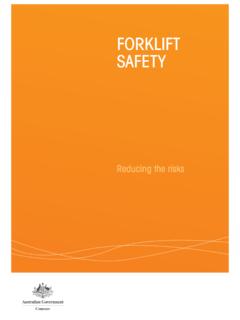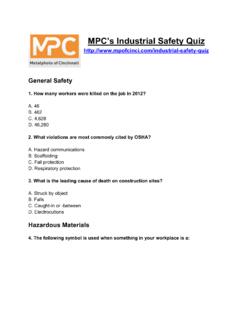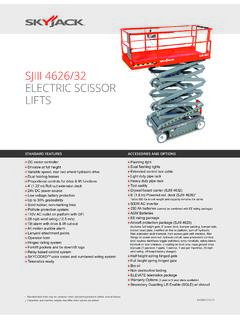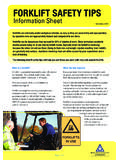Transcription of Forklift Safety Hazards - RiskTech
1 Technical Bulletin No 18 PO Box 367 Annerley QLD 4103 Phone: 07 3435 5111 Fax: 07 3891 1356 PO Box 3037 Auburn Vic 3123 Phone: 03 9815 6600 Fax: 03 9818 0255 PO Box 3100 Rhodes NSW 2138 Phone: 02 8745 2045 Fax: 02 9745 5969 PO Box 291 Fullarton SA 5063 Phone: 08 8379 5301 Fax: 08 8338 6091 Page 1 No 18 2009 Tech Bulletin - Forklift Hazards RiskTech Pty Limited Date Issued: 19 August 2009 Forklift Safety Hazards Each year hundreds of people are seriously injured or even killed while working or standing in the vicinity of forklifts . Even while travelling at very slow speeds, forklifts can potentially crush and severely injure bystanders, tip over or lose its load when operators carelessly drive or brake heavily.
2 Such workplace accidents can have serious consequences on lives, individuals, families and businesses and there is a zero tolerance approach, by OH&S regulators in Australia, to the unsafe operation of forklifts . It is for these reasons companies should regularly update Safety procedures and review traffic management plan since forklifts have the potential to be one of the most dangerous pieces of plant in the workplace. Providing a safe work environment, safe work practices and safe plant and equipment for all individuals means employers must do all they can to prevent Forklift accidents. According to WORKSAFE VICTORIA1, between the 1st of January 1985 and 30th of January 2006, there have been a total of 56 deaths in Victoria alone involving Forklift trucks.
3 A statistical summary is shown below: It is important to note this figure does not portray the number of Forklift accidents that result in serious injury which are expected to be in the thousands and does not include the unreported, minor and near miss injuries and incidents which occur each year throughout Australia. 1 Worksafe Victoria, Forklift Safety Reducing the Risk, 2nd Edition, February 2006. 29%12%12%18%13%14%2%56 Reported Fatalities Involving Forklift TruckesPedestrian crushed by falling loadsPedestrian struck by travelling forkliftPedestrian crushed by manoeuring forkliftOperator crushed by Forklift in tipover/rolloveroperator crushed by unexpected movement of forkliftFell from Forklift , forkarms or loadOperator overcome by exhaust fumes Technical Bulletin No 18 PO Box 367 Annerley QLD 4103 Phone: 07 3435 5111 Fax: 07 3891 1356 PO Box 3037 Auburn Vic 3123 Phone: 03 9815 6600 Fax: 03 9818 0255 PO Box 3100 Rhodes NSW 2138 Phone: 02 8745 2045 Fax: 02 9745 5969 PO Box 291 Fullarton SA 5063 Phone: 08 8379 5301 Fax.
4 08 8338 6091 Page 2 No 18 2009 Tech Bulletin - Forklift Hazards RiskTech Pty Limited Date Issued: 19 August 2009 Not only should organisations implement preventative measures, it is also equally important that Forklift truck operators identify workplace Hazards by walking around the facility and having a look out for: Overhead power-Lines Uneven floors Blind corners Ramps Pedestrian thoroughfares Overhead pipes and fittings Low doorways Confined spaces Hazardous areas Some of the most common Hazards that occur around forklifts include: Collisions with stationary or moving objects; Injury to bystanders; Driver musculoskeletal injuries; forklifts recharged or refuelled unsafely; forklifts overturning due to improper loading, careless driving or unstable ground; and Heavy loads falling off the lift.
5 By implementing a risk management approach, a safe system of work can be developed making forklifts and their operation as safe as possible. Developing such a systematic method involves: Identifying the Hazards (anything which has the potential to cause an injury or present a danger to individuals); Assessing the risk ( determining the likelihood together with the consequence of such a hazard resulting); Evaluating what control measures to take (Deciding on which risk management strategy to implement); and Applying, reviewing and monitoring these control measures. For Fire Safety Recharging Battery Powered Industrial Trucks, refer to Technical Bulletin 12.
6 To help employers meet their obligations under the Occupational Health and Safety Act, Appendix 1 was devised as a checklist to see whether your company s policies and procedures address such preventative measures. The safer a workplace is, the less likely an accident should occur. Preventative steps to pinpoint and minimise workplace Hazards is a legal necessity and it is important to make sure employees are aware of the risks and the necessary procedures that they need to follow. Technical Bulletin No 18 PO Box 367 Annerley QLD 4103 Phone: 07 3435 5111 Fax: 07 3891 1356 PO Box 3037 Auburn Vic 3123 Phone: 03 9815 6600 Fax: 03 9818 0255 PO Box 3100 Rhodes NSW 2138 Phone: 02 8745 2045 Fax: 02 9745 5969 PO Box 291 Fullarton SA 5063 Phone: 08 8379 5301 Fax: 08 8338 6091 Page 3 No 18 2009 Tech Bulletin - Forklift Hazards RiskTech Pty Limited Date Issued: 19 August 2009 Forklift Checklist For Best Practice Purchasing, Hiring or Leasing forklifts Does the vehicle meet Australian Standards (AS 1995: Powered Industrial Trucks)?
7 Does the vehicle have adequate operating controls, warning devices, emission control systems and sufficient visibility for safe operation? Does the Forklift have an ergonomically designed driver s seat to prevent driver musculoskeletal injuries? Is the vehicle suitable for the intended operating environment uneven or rough surfaces, explosive atmospheres? Operator Supervision Is the Forklift inspected daily and have problems reported? Are Forklift operators authorised trainees or hold a certificate of competency? Are operators informed on the latest company Forklift procedures? Do operators know how to check that loads are within the rated load capacity, are securely stacked and that stack heights don t exceed the maximum recommended?
8 Do Forklift operators whilst parking remove the ignition/starter switch key when leaving the vehicle unattended? Do operators avoid parking in doorways, entrances, emergency exits or in front of fire extinguishing equipment? Is there a procedure for dealing with unsafe Forklift trucks such as isolating and tagging the Forklift , or reporting the matter to the appropriate person? Safe Work Areas Are pedestrian and vehicle traffic routes segregated? Are crossing points clearly visible to pedestrians and Forklift users? Are loading/unloading zones demarcated and pedestrian free zones. Are suitable Safety features (such as direction, speed limits, speed bumps and priority signs, etc) clearly marked and fitted in the workplace?
9 Are critical machinery, equipment and building essentials (such as racks, switchboards or composite panels) impact protected? Are forklifts well maintained and is there a preventative maintenance programme in place? Battery Charging & Refuelling Electric forklifts - Are battery charging bays located in areas well separated from any combustible storage (minimum 3 metres) and in areas adequately ventilated? LPG forklifts - Are LPG refuelling tanks well separated from any building, locked off when not in use and accessed only to operators who have been trained to refuel? LPG forklifts Are replacement LPG cylinders stored in a suitable location and are operators trained to replace these cylinders in a safe manner?
10







